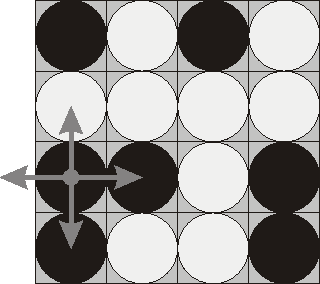本文主要是介绍POJ 1753 Flip Game【翻转棋盘+枚举+dfs】,希望对大家解决编程问题提供一定的参考价值,需要的开发者们随着小编来一起学习吧!
方法:一、枚举(此处所用)
二、用二进制记录下标(尚未实现)
三、类比于玩魔方游戏(思路来自黄超,尚未实现)
原题链接:http://poj.org/problem?id=1753
Flip Game
| Time Limit: 1000MS | Memory Limit: 65536K | |
| Total Submissions: 21024 | Accepted: 9108 |
Description
Flip game is played on a rectangular 4x4 field with two-sided pieces placed on each of its 16 squares. One side of each piece is white and the other one is black and each piece is lying either it's black or white side up. Each round you flip 3 to 5 pieces, thus changing the color of their upper side from black to white and vice versa. The pieces to be flipped are chosen every round according to the following rules:
 Consider the following position as an example:
Consider the following position as an example:
bwbw
wwww
bbwb
bwwb
Here "b" denotes pieces lying their black side up and "w" denotes pieces lying their white side up. If we choose to flip the 1st piece from the 3rd row (this choice is shown at the picture), then the field will become:
bwbw
bwww
wwwb
wwwb
The goal of the game is to flip either all pieces white side up or all pieces black side up. You are to write a program that will search for the minimum number of rounds needed to achieve this goal.
- Choose any one of the 16 pieces.
- Flip the chosen piece and also all adjacent pieces to the left, to the right, to the top, and to the bottom of the chosen piece (if there are any).
 Consider the following position as an example:
Consider the following position as an example: bwbw
wwww
bbwb
bwwb
Here "b" denotes pieces lying their black side up and "w" denotes pieces lying their white side up. If we choose to flip the 1st piece from the 3rd row (this choice is shown at the picture), then the field will become:
bwbw
bwww
wwwb
wwwb
The goal of the game is to flip either all pieces white side up or all pieces black side up. You are to write a program that will search for the minimum number of rounds needed to achieve this goal.
Input
The input consists of 4 lines with 4 characters "w" or "b" each that denote game field position.
Output
Write to the output file a single integer number - the minimum number of rounds needed to achieve the goal of the game from the given position. If the goal is initially achieved, then write 0. If it's impossible to achieve the goal, then write the word "Impossible" (without quotes).
Sample Input
bwwb bbwb bwwb bwww
Sample Output
4
Source
Northeastern Europe 2000
题意:
给你一个4*4棋盘,上面有且仅有白色(w)和黑色(b)两种颜色标记,并且,如果正面是白色,反面则是黑色,反之亦然。
现在让你翻转棋盘,问最少翻转多少次,使得最后棋盘的颜色统一(即全为白色或者全为黑色)。
如果不能翻转成功,则输出Impossible;否则,输出翻转成功的最小次数。
注意:翻转方法,如果你翻转了一个棋盘的格子,那么此格子的上下左右格子就均被翻转。
算法:枚举+dfs+回溯
#include<stdio.h>
#include<iostream>
using namespace std;
int chess[4][4];
int c=33;
void build()//将棋盘的颜色以标记化
{char c;int i,j;for(i=0;i<4;i++)for(j=0;j<4;j++){cin>>c;if(c=='w')chess[i][j]=0;elsechess[i][j]=1;}
}
void turn(int x,int y)//翻转
{if(x>=0&&x<=3&&y>=0&&y<=3)chess[x][y]=!chess[x][y];
}
void flip(int s)//一个棋子变化,周围四个都要变化
{int i=s/4;//行int j=s%4;//列turn(i,j);turn(i+1,j);turn(i,j+1);turn(i-1,j);turn(i,j-1);
}
int complete()//判断棋盘是否变成同一的颜色
{int i,j,s1=0;for(i=0;i<4;i++)for(j=0;j<4;j++)s1+=chess[i][j];if(s1%16)return 0;elsereturn 1;
}
void dfs(int s,int b)//进行深搜.s代表当前的方格,b代表翻转的方格数
{if(complete())//如果是同一颜色,找到最终状态{if(c>b)c=b;return;}if(s>=16)//如果遍历完return;dfs(s+1,b);flip(s);dfs(s+1,b+1);flip(s);
}
int main()
{build();//将棋盘的颜色以标记化dfs(0,0);if(c==33)//由于翻转次数最多为4*4*2=32次printf("Impossible\n");elseprintf("%d\n",c);return 0;
}这篇关于POJ 1753 Flip Game【翻转棋盘+枚举+dfs】的文章就介绍到这儿,希望我们推荐的文章对编程师们有所帮助!





